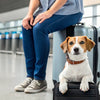What Weight Dog Can Fly in Cabin: A Comprehensive Guide for Pet Owners
- Houndsy
Table of Contents
- Introduction
- Understanding Airline Policies on Pet Travel
- Choosing the Right Carrier for Your Dog
- Preparing Your Dog for Air Travel
- What to Expect at the Airport
- After the Flight: Arrival and Adjustment
- Conclusion
- FAQ
Introduction
Did you know that nearly 2 million pets travel by air each year in the United States alone? As pet owners, we understand the desire to bring our furry friends along on adventures, whether it's a family vacation or a move to a new city. However, navigating the world of air travel with dogs can be overwhelming. One of the most common questions we encounter is, “What weight dog can fly in cabin?” This question is crucial for pet owners planning to bring their dogs onboard, as airlines have specific policies regarding pet size and weight.
In this blog post, we will explore the weight limits for dogs flying in cabin, the regulations set by various airlines, and tips to ensure a smooth travel experience for you and your pet. By the end of this article, you will have a comprehensive understanding of how to prepare for traveling with your dog in the cabin, the requirements to meet, and how to select the right airline for your needs. We encourage you to reflect on your own pet's size and preferences as we delve into this essential topic.
The Importance of Understanding Air Travel Regulations for Dogs
As we begin to unpack the details of traveling with dogs, it’s essential to acknowledge that understanding the regulations can significantly impact your travel plans. Not only will this knowledge help you avoid potential pitfalls, but it will also ensure the safety and comfort of your pet during the journey. With our commitment to simplifying and elevating the pet care experience, we aim to provide pet owners with the information they need to travel with confidence.
Understanding Airline Policies on Pet Travel
General Guidelines on Pet Size and Weight
Most airlines permit small dogs to fly in the cabin as long as they meet specific size and weight requirements. Generally, the maximum weight for dogs to travel in-cabin ranges from 15 to 20 pounds, including their carrier. However, these limits can vary significantly between airlines, so it’s crucial to check the specific guidelines for your chosen carrier.
- American Airlines: Allows dogs up to 20 pounds in a carrier that fits under the seat in front of you.
- Delta Air Lines: Dogs must fit in a carrier that does not exceed 18 inches in length and must be well-behaved.
- Southwest Airlines: Permits pets that can fit comfortably in a carrier under the seat, typically up to 18.5 inches in length.
Factors Influencing Airline Policies
Several factors influence airline policies regarding pet travel, including:
- Aircraft Type: Different aircraft have varying under-seat dimensions, which can affect the size of the carrier you can bring onboard.
- Weight Limitations: Each airline has its own weight limits for pets, often ranging from 15 to 20 pounds. It's vital to confirm these limits before booking your flight.
- Breed Restrictions: Some airlines may have restrictions on specific breeds, particularly brachycephalic (flat-faced) dogs, due to their susceptibility to respiratory issues during flights.
Preparing for Your Flight
To ensure a seamless travel experience, we recommend the following steps:
- Check Airline Policies: Before booking your flight, visit the airline’s website to review their pet travel policies thoroughly.
- Book Early: Many airlines have a limited number of spots available for pets in the cabin. Booking early increases your chances of securing a spot for your dog.
- Measure Your Dog: Ensure your dog fits comfortably in the carrier and meets the weight requirements. Measure your dog’s height and length to confirm they will fit under the seat.
Choosing the Right Carrier for Your Dog
Carrier Specifications
Airlines have specific requirements for pet carriers that must be adhered to for your dog to travel in the cabin. Here are some general specifications to keep in mind:
- Dimensions: The carrier must fit under the seat in front of you. Most airlines allow carriers up to 18-20 inches long, 13 inches wide, and 9 inches high.
- Ventilation: Ensure the carrier has adequate ventilation on multiple sides to promote airflow and comfort during the flight.
- Durability: The carrier should be sturdy enough to withstand the rigors of travel while being comfortable for your dog.
Selecting a Carrier
When choosing a carrier, we recommend looking for one that is:
- IATA-approved: Ensure that the carrier complies with International Air Transport Association (IATA) guidelines, as many airlines follow these standards.
- Comfortable: Your dog should be able to stand, turn around, and lie down comfortably inside the carrier.
- Familiar: Familiarize your dog with the carrier before the flight. Allow them to explore it at home and associate it with positive experiences, such as treats and praise.
Preparing Your Dog for Air Travel
Health and Safety Considerations
Before flying, it’s essential to ensure your dog is healthy enough for air travel. Here are some key considerations:
- Veterinary Check-Up: Schedule a visit with your veterinarian to confirm your dog is fit for travel. Discuss any health concerns that may arise during the flight.
- Vaccinations: Ensure your dog is up-to-date on vaccinations, as some destinations have specific requirements for traveling pets.
- Health Certificate: Some airlines may require a health certificate issued by a veterinarian within a specified timeframe before travel.
Acclimating Your Dog to the Carrier
Familiarizing your dog with the carrier can significantly reduce travel anxiety. Here are some tips:
- Positive Reinforcement: Encourage your dog to enter the carrier using treats and praise. Make it a cozy space by adding their favorite blanket or toy.
- Practice Runs: Take your dog on short car rides in the carrier to simulate travel conditions and help them adjust to the experience.
What to Expect at the Airport
Check-In Process
When you arrive at the airport, follow these steps for a smooth check-in process:
- Arrive Early: Allow ample time for check-in, security screening, and any potential delays.
- TSA Guidelines: Be prepared to take your dog out of the carrier during the TSA screening process. The carrier will go through the scanner, and TSA personnel may inspect your dog’s collar or harness.
- Pet Relief Areas: After check-in, locate pet relief areas in the airport to allow your dog to stretch their legs and relieve themselves before the flight.
Boarding the Flight
Once it’s time to board, keep these tips in mind:
- Calm Environment: Maintain a calm demeanor while boarding to help your dog feel secure.
- Under-Seat Placement: Place the carrier under the seat in front of you and ensure your dog remains inside for the duration of the flight.
- Comfort Items: Provide familiar items, like a blanket or toy, to help soothe your dog during the flight.
After the Flight: Arrival and Adjustment
Settling In
Once you arrive at your destination, allow your dog time to adjust to their new surroundings. Here’s how to make the transition smoother:
- Explore Together: Take your dog for a walk around the new area to help them acclimate and expend energy after being confined during the flight.
- Hydration: Offer water and snacks to keep your dog hydrated and nourished.
- Reinforce Positive Behavior: Praise your dog for good behavior and provide them with a comfortable space to rest.
Conclusion
Traveling with your dog can be a rewarding experience when you understand the regulations and prepare adequately. By knowing what weight dog can fly in cabin and following airline guidelines, you can ensure a smooth and enjoyable trip for both you and your furry friend.
As we embark on our journeys, let’s embrace the joy of sharing experiences with our dogs while prioritizing their comfort and safety. Now that you have the information you need, are you ready to plan your next adventure with your pet?
If you're looking to elevate your pet care experience, consider exploring the Houndsy Kibble Dispenser, designed to simplify daily feeding rituals with style and convenience. Order Now.
FAQ
What is the typical weight limit for dogs flying in the cabin?
Most airlines allow dogs weighing between 15 to 20 pounds to travel in the cabin, including their carrier.
Can I bring more than one dog in the cabin?
Some airlines permit two dogs of similar size to travel in the same carrier, but this varies by airline. Always check specific policies before booking.
What documentation is required for my dog to fly?
Airlines may require a health certificate and proof of vaccinations. It's best to consult your veterinarian and the airline for specific requirements.
Are there any breeds that cannot fly in the cabin?
Yes, certain airlines have restrictions on brachycephalic breeds due to respiratory concerns. Check with your airline for their specific policies.
How can I ensure my dog is comfortable during the flight?
Familiarize your dog with their carrier, bring comfort items, and maintain a calm demeanor throughout the journey to help your dog feel secure.












